Business Administration Report: Office Management at Sainsbury's
VerifiedAdded on 2020/10/22
|13
|4199
|402
Report
AI Summary
This report provides a comprehensive analysis of business administration, focusing on the operational activities within an organization, using Sainsbury's as a case study. The report delves into the legal requirements of office management, encompassing health and safety regulations, information management, and employee welfare. It details the typical services provided by an office facility and outlines procedures for establishing and managing office resources, including equipment, staffing, and stationery. Furthermore, the report explores techniques for monitoring and managing workflows, emphasizing the importance of efficiency. It examines the legal obligations of employers and employees regarding health and safety, along with accident and emergency procedures. The report also covers meeting minutes, their purpose, legal implications, and the importance of accuracy, as well as how to take notes. It analyzes different types of meetings, the roles of participants, and facilitation techniques. Finally, the report addresses event planning, including event characteristics, information requirements, and resource identification. This report provides valuable insights into the multifaceted aspects of business administration within a real-world context.

BUSINESS
ADMINISTRATION
ADMINISTRATION
Paraphrase This Document
Need a fresh take? Get an instant paraphrase of this document with our AI Paraphraser
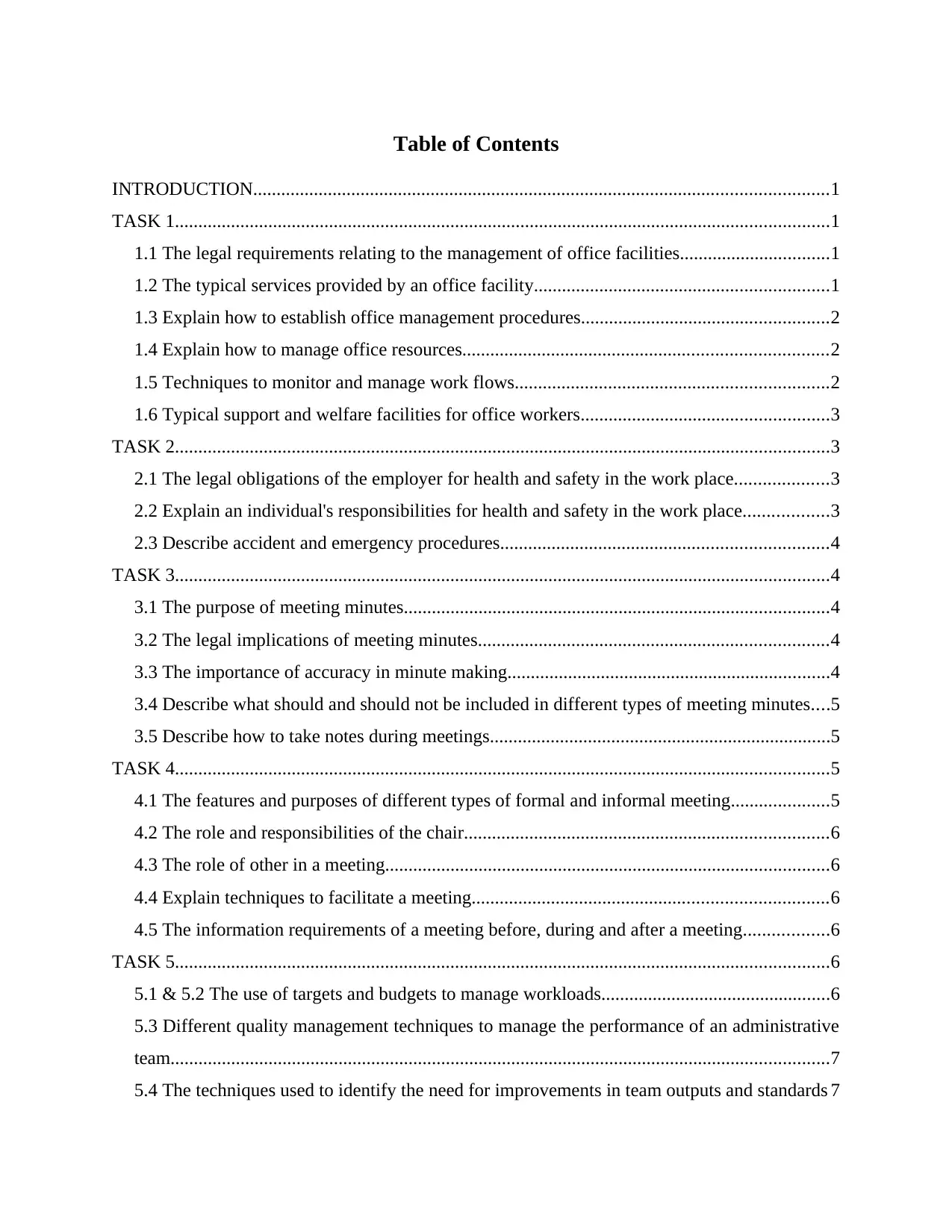
Table of Contents
INTRODUCTION...........................................................................................................................1
TASK 1............................................................................................................................................1
1.1 The legal requirements relating to the management of office facilities................................1
1.2 The typical services provided by an office facility...............................................................1
1.3 Explain how to establish office management procedures.....................................................2
1.4 Explain how to manage office resources..............................................................................2
1.5 Techniques to monitor and manage work flows...................................................................2
1.6 Typical support and welfare facilities for office workers.....................................................3
TASK 2............................................................................................................................................3
2.1 The legal obligations of the employer for health and safety in the work place....................3
2.2 Explain an individual's responsibilities for health and safety in the work place..................3
2.3 Describe accident and emergency procedures......................................................................4
TASK 3............................................................................................................................................4
3.1 The purpose of meeting minutes...........................................................................................4
3.2 The legal implications of meeting minutes...........................................................................4
3.3 The importance of accuracy in minute making.....................................................................4
3.4 Describe what should and should not be included in different types of meeting minutes....5
3.5 Describe how to take notes during meetings.........................................................................5
TASK 4............................................................................................................................................5
4.1 The features and purposes of different types of formal and informal meeting.....................5
4.2 The role and responsibilities of the chair..............................................................................6
4.3 The role of other in a meeting...............................................................................................6
4.4 Explain techniques to facilitate a meeting............................................................................6
4.5 The information requirements of a meeting before, during and after a meeting..................6
TASK 5............................................................................................................................................6
5.1 & 5.2 The use of targets and budgets to manage workloads.................................................6
5.3 Different quality management techniques to manage the performance of an administrative
team.............................................................................................................................................7
5.4 The techniques used to identify the need for improvements in team outputs and standards 7
INTRODUCTION...........................................................................................................................1
TASK 1............................................................................................................................................1
1.1 The legal requirements relating to the management of office facilities................................1
1.2 The typical services provided by an office facility...............................................................1
1.3 Explain how to establish office management procedures.....................................................2
1.4 Explain how to manage office resources..............................................................................2
1.5 Techniques to monitor and manage work flows...................................................................2
1.6 Typical support and welfare facilities for office workers.....................................................3
TASK 2............................................................................................................................................3
2.1 The legal obligations of the employer for health and safety in the work place....................3
2.2 Explain an individual's responsibilities for health and safety in the work place..................3
2.3 Describe accident and emergency procedures......................................................................4
TASK 3............................................................................................................................................4
3.1 The purpose of meeting minutes...........................................................................................4
3.2 The legal implications of meeting minutes...........................................................................4
3.3 The importance of accuracy in minute making.....................................................................4
3.4 Describe what should and should not be included in different types of meeting minutes....5
3.5 Describe how to take notes during meetings.........................................................................5
TASK 4............................................................................................................................................5
4.1 The features and purposes of different types of formal and informal meeting.....................5
4.2 The role and responsibilities of the chair..............................................................................6
4.3 The role of other in a meeting...............................................................................................6
4.4 Explain techniques to facilitate a meeting............................................................................6
4.5 The information requirements of a meeting before, during and after a meeting..................6
TASK 5............................................................................................................................................6
5.1 & 5.2 The use of targets and budgets to manage workloads.................................................6
5.3 Different quality management techniques to manage the performance of an administrative
team.............................................................................................................................................7
5.4 The techniques used to identify the need for improvements in team outputs and standards 7
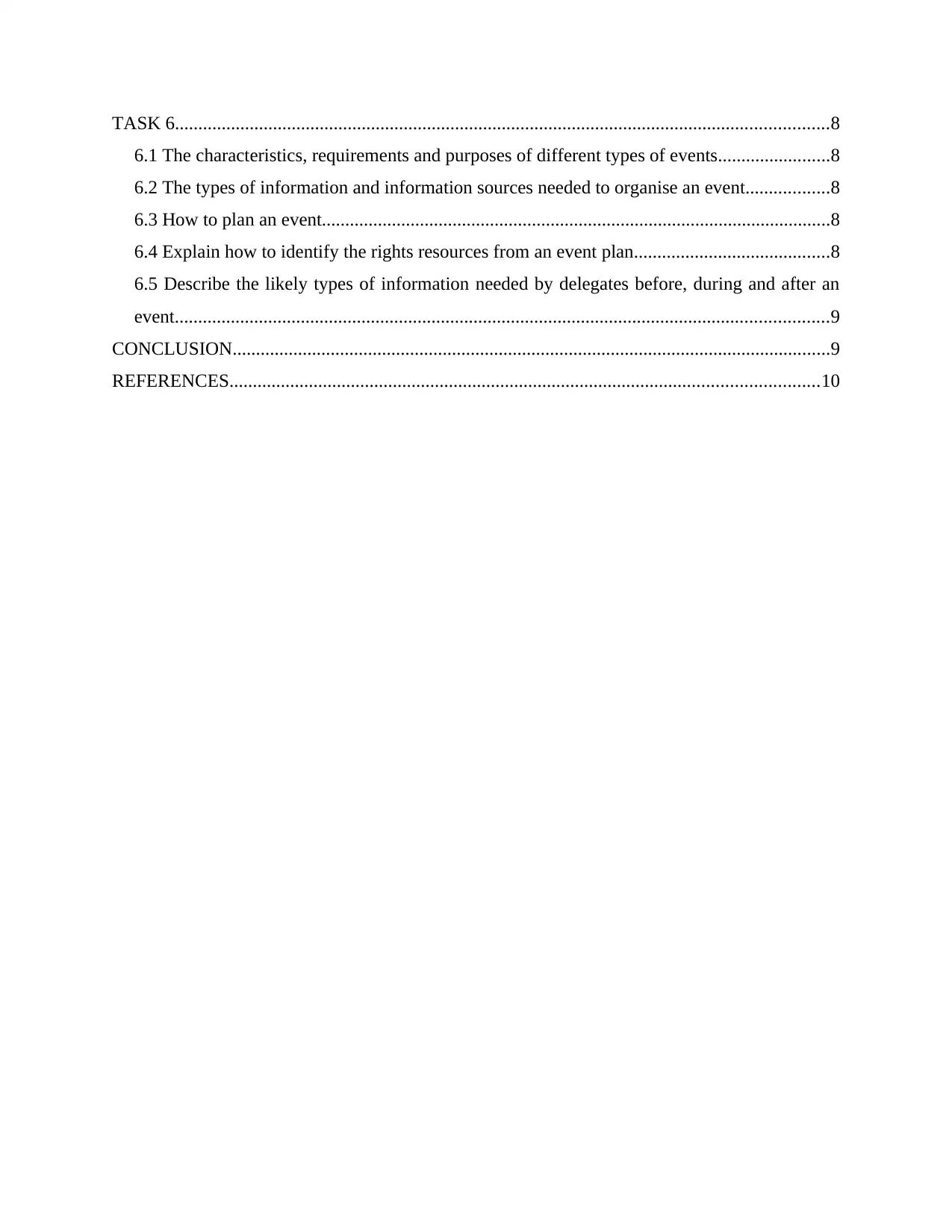
TASK 6............................................................................................................................................8
6.1 The characteristics, requirements and purposes of different types of events........................8
6.2 The types of information and information sources needed to organise an event..................8
6.3 How to plan an event.............................................................................................................8
6.4 Explain how to identify the rights resources from an event plan..........................................8
6.5 Describe the likely types of information needed by delegates before, during and after an
event............................................................................................................................................9
CONCLUSION................................................................................................................................9
REFERENCES..............................................................................................................................10
6.1 The characteristics, requirements and purposes of different types of events........................8
6.2 The types of information and information sources needed to organise an event..................8
6.3 How to plan an event.............................................................................................................8
6.4 Explain how to identify the rights resources from an event plan..........................................8
6.5 Describe the likely types of information needed by delegates before, during and after an
event............................................................................................................................................9
CONCLUSION................................................................................................................................9
REFERENCES..............................................................................................................................10
⊘ This is a preview!⊘
Do you want full access?
Subscribe today to unlock all pages.

Trusted by 1+ million students worldwide
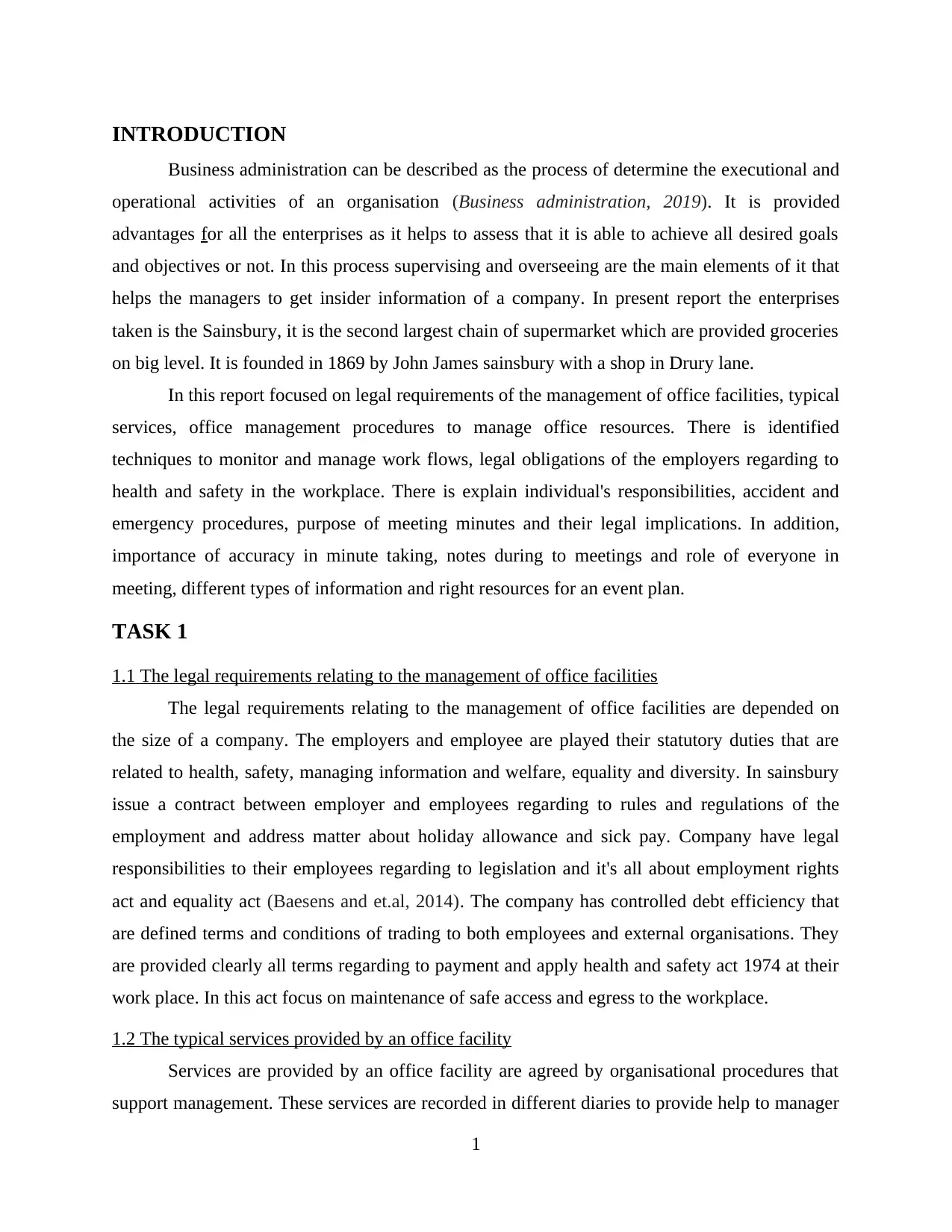
INTRODUCTION
Business administration can be described as the process of determine the executional and
operational activities of an organisation (Business administration, 2019). It is provided
advantages for all the enterprises as it helps to assess that it is able to achieve all desired goals
and objectives or not. In this process supervising and overseeing are the main elements of it that
helps the managers to get insider information of a company. In present report the enterprises
taken is the Sainsbury, it is the second largest chain of supermarket which are provided groceries
on big level. It is founded in 1869 by John James sainsbury with a shop in Drury lane.
In this report focused on legal requirements of the management of office facilities, typical
services, office management procedures to manage office resources. There is identified
techniques to monitor and manage work flows, legal obligations of the employers regarding to
health and safety in the workplace. There is explain individual's responsibilities, accident and
emergency procedures, purpose of meeting minutes and their legal implications. In addition,
importance of accuracy in minute taking, notes during to meetings and role of everyone in
meeting, different types of information and right resources for an event plan.
TASK 1
1.1 The legal requirements relating to the management of office facilities
The legal requirements relating to the management of office facilities are depended on
the size of a company. The employers and employee are played their statutory duties that are
related to health, safety, managing information and welfare, equality and diversity. In sainsbury
issue a contract between employer and employees regarding to rules and regulations of the
employment and address matter about holiday allowance and sick pay. Company have legal
responsibilities to their employees regarding to legislation and it's all about employment rights
act and equality act (Baesens and et.al, 2014). The company has controlled debt efficiency that
are defined terms and conditions of trading to both employees and external organisations. They
are provided clearly all terms regarding to payment and apply health and safety act 1974 at their
work place. In this act focus on maintenance of safe access and egress to the workplace.
1.2 The typical services provided by an office facility
Services are provided by an office facility are agreed by organisational procedures that
support management. These services are recorded in different diaries to provide help to manager
1
Business administration can be described as the process of determine the executional and
operational activities of an organisation (Business administration, 2019). It is provided
advantages for all the enterprises as it helps to assess that it is able to achieve all desired goals
and objectives or not. In this process supervising and overseeing are the main elements of it that
helps the managers to get insider information of a company. In present report the enterprises
taken is the Sainsbury, it is the second largest chain of supermarket which are provided groceries
on big level. It is founded in 1869 by John James sainsbury with a shop in Drury lane.
In this report focused on legal requirements of the management of office facilities, typical
services, office management procedures to manage office resources. There is identified
techniques to monitor and manage work flows, legal obligations of the employers regarding to
health and safety in the workplace. There is explain individual's responsibilities, accident and
emergency procedures, purpose of meeting minutes and their legal implications. In addition,
importance of accuracy in minute taking, notes during to meetings and role of everyone in
meeting, different types of information and right resources for an event plan.
TASK 1
1.1 The legal requirements relating to the management of office facilities
The legal requirements relating to the management of office facilities are depended on
the size of a company. The employers and employee are played their statutory duties that are
related to health, safety, managing information and welfare, equality and diversity. In sainsbury
issue a contract between employer and employees regarding to rules and regulations of the
employment and address matter about holiday allowance and sick pay. Company have legal
responsibilities to their employees regarding to legislation and it's all about employment rights
act and equality act (Baesens and et.al, 2014). The company has controlled debt efficiency that
are defined terms and conditions of trading to both employees and external organisations. They
are provided clearly all terms regarding to payment and apply health and safety act 1974 at their
work place. In this act focus on maintenance of safe access and egress to the workplace.
1.2 The typical services provided by an office facility
Services are provided by an office facility are agreed by organisational procedures that
support management. These services are recorded in different diaries to provide help to manager
1
Paraphrase This Document
Need a fresh take? Get an instant paraphrase of this document with our AI Paraphraser
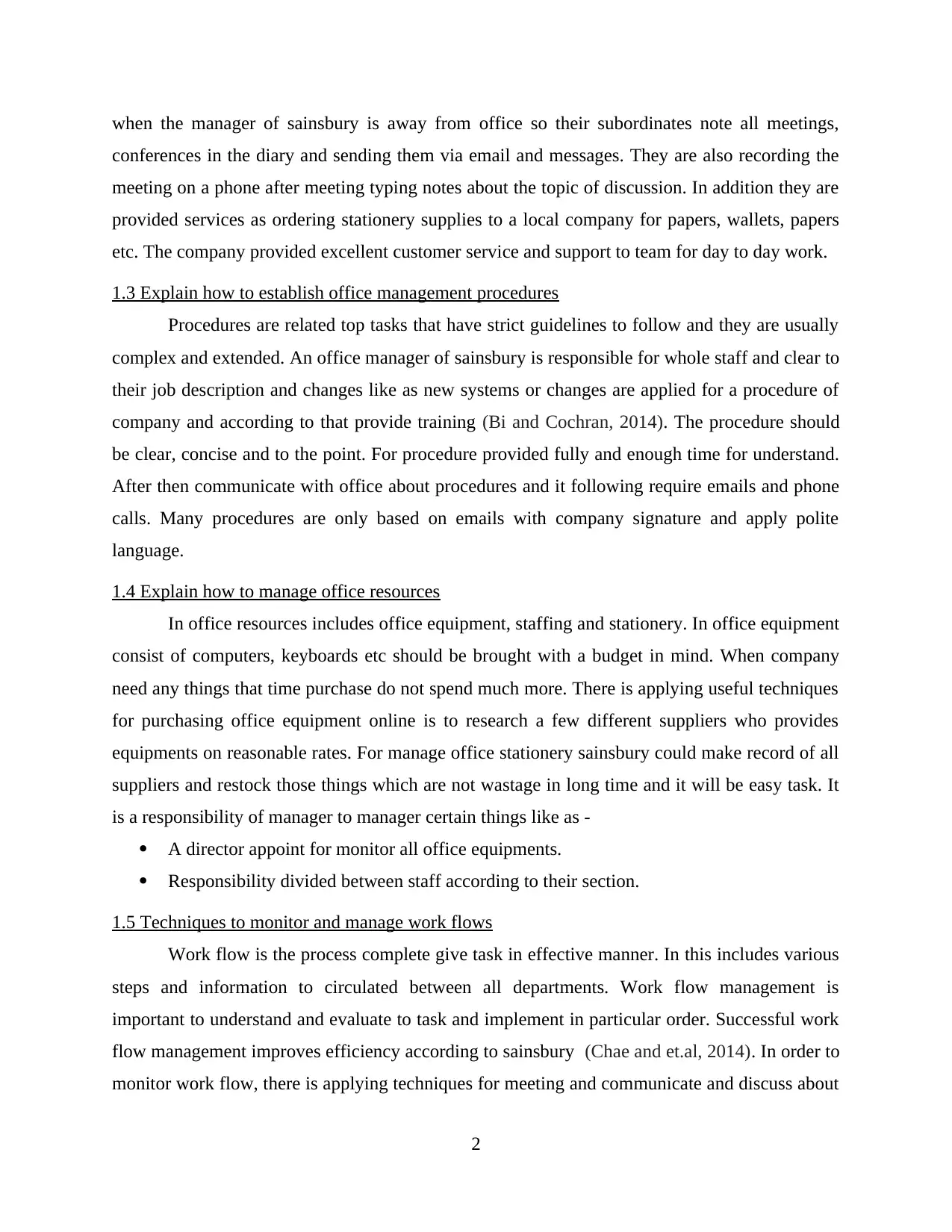
when the manager of sainsbury is away from office so their subordinates note all meetings,
conferences in the diary and sending them via email and messages. They are also recording the
meeting on a phone after meeting typing notes about the topic of discussion. In addition they are
provided services as ordering stationery supplies to a local company for papers, wallets, papers
etc. The company provided excellent customer service and support to team for day to day work.
1.3 Explain how to establish office management procedures
Procedures are related top tasks that have strict guidelines to follow and they are usually
complex and extended. An office manager of sainsbury is responsible for whole staff and clear to
their job description and changes like as new systems or changes are applied for a procedure of
company and according to that provide training (Bi and Cochran, 2014). The procedure should
be clear, concise and to the point. For procedure provided fully and enough time for understand.
After then communicate with office about procedures and it following require emails and phone
calls. Many procedures are only based on emails with company signature and apply polite
language.
1.4 Explain how to manage office resources
In office resources includes office equipment, staffing and stationery. In office equipment
consist of computers, keyboards etc should be brought with a budget in mind. When company
need any things that time purchase do not spend much more. There is applying useful techniques
for purchasing office equipment online is to research a few different suppliers who provides
equipments on reasonable rates. For manage office stationery sainsbury could make record of all
suppliers and restock those things which are not wastage in long time and it will be easy task. It
is a responsibility of manager to manager certain things like as -
A director appoint for monitor all office equipments.
Responsibility divided between staff according to their section.
1.5 Techniques to monitor and manage work flows
Work flow is the process complete give task in effective manner. In this includes various
steps and information to circulated between all departments. Work flow management is
important to understand and evaluate to task and implement in particular order. Successful work
flow management improves efficiency according to sainsbury (Chae and et.al, 2014). In order to
monitor work flow, there is applying techniques for meeting and communicate and discuss about
2
conferences in the diary and sending them via email and messages. They are also recording the
meeting on a phone after meeting typing notes about the topic of discussion. In addition they are
provided services as ordering stationery supplies to a local company for papers, wallets, papers
etc. The company provided excellent customer service and support to team for day to day work.
1.3 Explain how to establish office management procedures
Procedures are related top tasks that have strict guidelines to follow and they are usually
complex and extended. An office manager of sainsbury is responsible for whole staff and clear to
their job description and changes like as new systems or changes are applied for a procedure of
company and according to that provide training (Bi and Cochran, 2014). The procedure should
be clear, concise and to the point. For procedure provided fully and enough time for understand.
After then communicate with office about procedures and it following require emails and phone
calls. Many procedures are only based on emails with company signature and apply polite
language.
1.4 Explain how to manage office resources
In office resources includes office equipment, staffing and stationery. In office equipment
consist of computers, keyboards etc should be brought with a budget in mind. When company
need any things that time purchase do not spend much more. There is applying useful techniques
for purchasing office equipment online is to research a few different suppliers who provides
equipments on reasonable rates. For manage office stationery sainsbury could make record of all
suppliers and restock those things which are not wastage in long time and it will be easy task. It
is a responsibility of manager to manager certain things like as -
A director appoint for monitor all office equipments.
Responsibility divided between staff according to their section.
1.5 Techniques to monitor and manage work flows
Work flow is the process complete give task in effective manner. In this includes various
steps and information to circulated between all departments. Work flow management is
important to understand and evaluate to task and implement in particular order. Successful work
flow management improves efficiency according to sainsbury (Chae and et.al, 2014). In order to
monitor work flow, there is applying techniques for meeting and communicate and discuss about
2

the work management to carry out any problems. Managers can evaluate work flow and prepare
progress report of the employees for detailing errors and logging data. Successful work flow
management helps to increase efficiency with in an organisation.
1.6 Typical support and welfare facilities for office workers
sainsbury will have separate human resource department who take care of recruitment,
job description, promotional vacancies and job specification, employer or employee relationship
and work based culture. It should be approachable on particular place where staff can go with
any concerns. This department encourage for training opportunities and manages their
performances and there is provided facility to employees by their employer -
Toilet, hand basins with soap and towels
Somewhere to rest and eat meals.
Drinking water
Locker facility with full safety.
TASK 2
2.1 The legal obligations of the employer for health and safety in the work place
Employers must meet the legal obligations regarding to health and safety legislation. It is
the duty of manager to provide facility related to health, safety and welfare of their employees. In
this consist of maintaining safe equipment, performing risk assessment, members of staff having
first aid training. The policy followed by external company so its called safe guard engineering
and it is important to maintained work environment according to employees. It is responsibility
of employer to identify and report hazards and dangerous occurrence.
2.2 Explain an individual's responsibilities for health and safety in the work place
The most essential responsibilities of employee are -
To co-ordinate with employer for making sure get proper training and understand rules
and regulation of company regarding to health and safety policies.
To report any injuries, illness and strains in order to change way of work
If in office drive or operate machinery so it is responsibility of employee to tell employer
for medication and move from job in temporary way (Corte Real, Oliveira and Ruivo,
2014).
To avoid to wearing to heavy jewellery and loose clothing while operating machinery.
3
progress report of the employees for detailing errors and logging data. Successful work flow
management helps to increase efficiency with in an organisation.
1.6 Typical support and welfare facilities for office workers
sainsbury will have separate human resource department who take care of recruitment,
job description, promotional vacancies and job specification, employer or employee relationship
and work based culture. It should be approachable on particular place where staff can go with
any concerns. This department encourage for training opportunities and manages their
performances and there is provided facility to employees by their employer -
Toilet, hand basins with soap and towels
Somewhere to rest and eat meals.
Drinking water
Locker facility with full safety.
TASK 2
2.1 The legal obligations of the employer for health and safety in the work place
Employers must meet the legal obligations regarding to health and safety legislation. It is
the duty of manager to provide facility related to health, safety and welfare of their employees. In
this consist of maintaining safe equipment, performing risk assessment, members of staff having
first aid training. The policy followed by external company so its called safe guard engineering
and it is important to maintained work environment according to employees. It is responsibility
of employer to identify and report hazards and dangerous occurrence.
2.2 Explain an individual's responsibilities for health and safety in the work place
The most essential responsibilities of employee are -
To co-ordinate with employer for making sure get proper training and understand rules
and regulation of company regarding to health and safety policies.
To report any injuries, illness and strains in order to change way of work
If in office drive or operate machinery so it is responsibility of employee to tell employer
for medication and move from job in temporary way (Corte Real, Oliveira and Ruivo,
2014).
To avoid to wearing to heavy jewellery and loose clothing while operating machinery.
3
⊘ This is a preview!⊘
Do you want full access?
Subscribe today to unlock all pages.

Trusted by 1+ million students worldwide
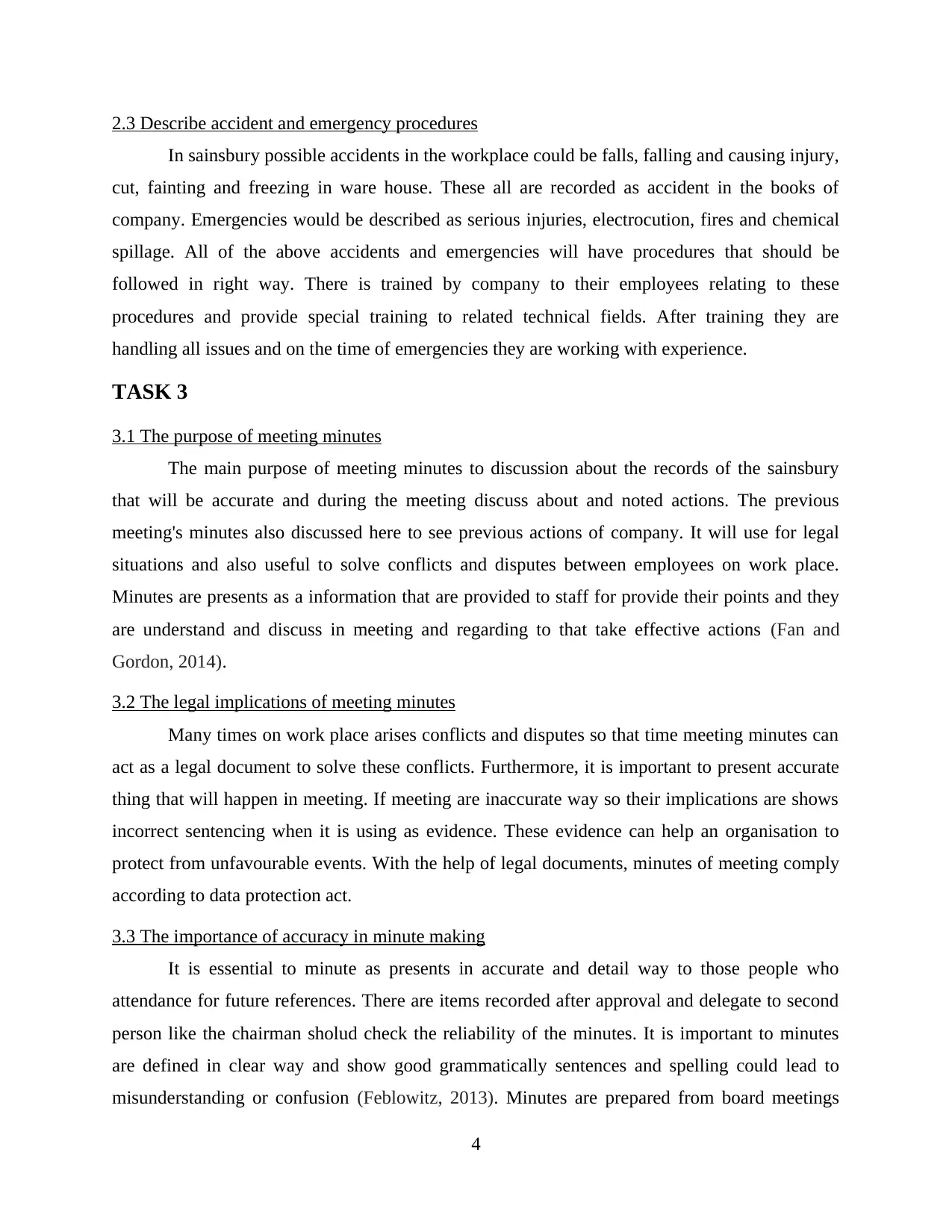
2.3 Describe accident and emergency procedures
In sainsbury possible accidents in the workplace could be falls, falling and causing injury,
cut, fainting and freezing in ware house. These all are recorded as accident in the books of
company. Emergencies would be described as serious injuries, electrocution, fires and chemical
spillage. All of the above accidents and emergencies will have procedures that should be
followed in right way. There is trained by company to their employees relating to these
procedures and provide special training to related technical fields. After training they are
handling all issues and on the time of emergencies they are working with experience.
TASK 3
3.1 The purpose of meeting minutes
The main purpose of meeting minutes to discussion about the records of the sainsbury
that will be accurate and during the meeting discuss about and noted actions. The previous
meeting's minutes also discussed here to see previous actions of company. It will use for legal
situations and also useful to solve conflicts and disputes between employees on work place.
Minutes are presents as a information that are provided to staff for provide their points and they
are understand and discuss in meeting and regarding to that take effective actions (Fan and
Gordon, 2014).
3.2 The legal implications of meeting minutes
Many times on work place arises conflicts and disputes so that time meeting minutes can
act as a legal document to solve these conflicts. Furthermore, it is important to present accurate
thing that will happen in meeting. If meeting are inaccurate way so their implications are shows
incorrect sentencing when it is using as evidence. These evidence can help an organisation to
protect from unfavourable events. With the help of legal documents, minutes of meeting comply
according to data protection act.
3.3 The importance of accuracy in minute making
It is essential to minute as presents in accurate and detail way to those people who
attendance for future references. There are items recorded after approval and delegate to second
person like the chairman sholud check the reliability of the minutes. It is important to minutes
are defined in clear way and show good grammatically sentences and spelling could lead to
misunderstanding or confusion (Feblowitz, 2013). Minutes are prepared from board meetings
4
In sainsbury possible accidents in the workplace could be falls, falling and causing injury,
cut, fainting and freezing in ware house. These all are recorded as accident in the books of
company. Emergencies would be described as serious injuries, electrocution, fires and chemical
spillage. All of the above accidents and emergencies will have procedures that should be
followed in right way. There is trained by company to their employees relating to these
procedures and provide special training to related technical fields. After training they are
handling all issues and on the time of emergencies they are working with experience.
TASK 3
3.1 The purpose of meeting minutes
The main purpose of meeting minutes to discussion about the records of the sainsbury
that will be accurate and during the meeting discuss about and noted actions. The previous
meeting's minutes also discussed here to see previous actions of company. It will use for legal
situations and also useful to solve conflicts and disputes between employees on work place.
Minutes are presents as a information that are provided to staff for provide their points and they
are understand and discuss in meeting and regarding to that take effective actions (Fan and
Gordon, 2014).
3.2 The legal implications of meeting minutes
Many times on work place arises conflicts and disputes so that time meeting minutes can
act as a legal document to solve these conflicts. Furthermore, it is important to present accurate
thing that will happen in meeting. If meeting are inaccurate way so their implications are shows
incorrect sentencing when it is using as evidence. These evidence can help an organisation to
protect from unfavourable events. With the help of legal documents, minutes of meeting comply
according to data protection act.
3.3 The importance of accuracy in minute making
It is essential to minute as presents in accurate and detail way to those people who
attendance for future references. There are items recorded after approval and delegate to second
person like the chairman sholud check the reliability of the minutes. It is important to minutes
are defined in clear way and show good grammatically sentences and spelling could lead to
misunderstanding or confusion (Feblowitz, 2013). Minutes are prepared from board meetings
4
Paraphrase This Document
Need a fresh take? Get an instant paraphrase of this document with our AI Paraphraser
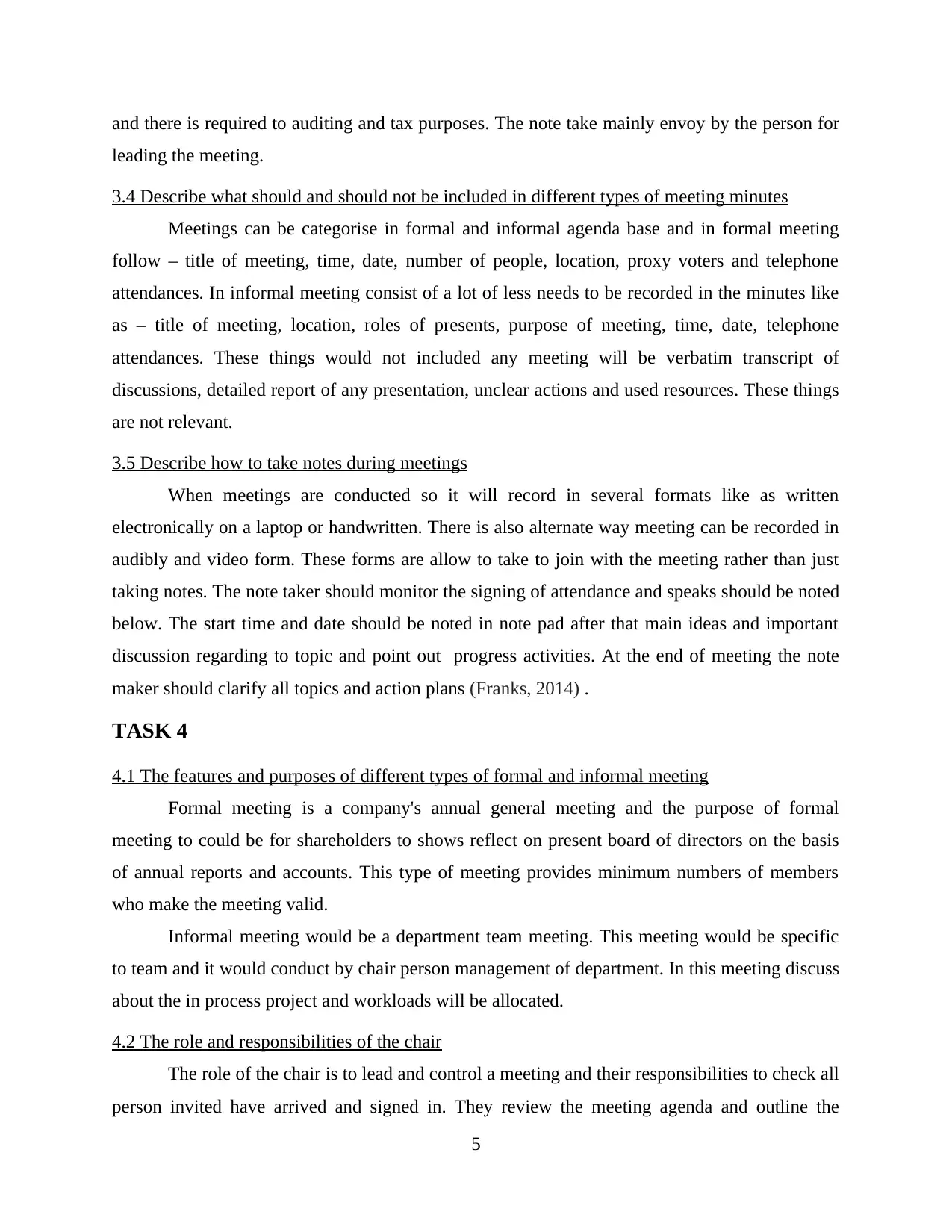
and there is required to auditing and tax purposes. The note take mainly envoy by the person for
leading the meeting.
3.4 Describe what should and should not be included in different types of meeting minutes
Meetings can be categorise in formal and informal agenda base and in formal meeting
follow – title of meeting, time, date, number of people, location, proxy voters and telephone
attendances. In informal meeting consist of a lot of less needs to be recorded in the minutes like
as – title of meeting, location, roles of presents, purpose of meeting, time, date, telephone
attendances. These things would not included any meeting will be verbatim transcript of
discussions, detailed report of any presentation, unclear actions and used resources. These things
are not relevant.
3.5 Describe how to take notes during meetings
When meetings are conducted so it will record in several formats like as written
electronically on a laptop or handwritten. There is also alternate way meeting can be recorded in
audibly and video form. These forms are allow to take to join with the meeting rather than just
taking notes. The note taker should monitor the signing of attendance and speaks should be noted
below. The start time and date should be noted in note pad after that main ideas and important
discussion regarding to topic and point out progress activities. At the end of meeting the note
maker should clarify all topics and action plans (Franks, 2014) .
TASK 4
4.1 The features and purposes of different types of formal and informal meeting
Formal meeting is a company's annual general meeting and the purpose of formal
meeting to could be for shareholders to shows reflect on present board of directors on the basis
of annual reports and accounts. This type of meeting provides minimum numbers of members
who make the meeting valid.
Informal meeting would be a department team meeting. This meeting would be specific
to team and it would conduct by chair person management of department. In this meeting discuss
about the in process project and workloads will be allocated.
4.2 The role and responsibilities of the chair
The role of the chair is to lead and control a meeting and their responsibilities to check all
person invited have arrived and signed in. They review the meeting agenda and outline the
5
leading the meeting.
3.4 Describe what should and should not be included in different types of meeting minutes
Meetings can be categorise in formal and informal agenda base and in formal meeting
follow – title of meeting, time, date, number of people, location, proxy voters and telephone
attendances. In informal meeting consist of a lot of less needs to be recorded in the minutes like
as – title of meeting, location, roles of presents, purpose of meeting, time, date, telephone
attendances. These things would not included any meeting will be verbatim transcript of
discussions, detailed report of any presentation, unclear actions and used resources. These things
are not relevant.
3.5 Describe how to take notes during meetings
When meetings are conducted so it will record in several formats like as written
electronically on a laptop or handwritten. There is also alternate way meeting can be recorded in
audibly and video form. These forms are allow to take to join with the meeting rather than just
taking notes. The note taker should monitor the signing of attendance and speaks should be noted
below. The start time and date should be noted in note pad after that main ideas and important
discussion regarding to topic and point out progress activities. At the end of meeting the note
maker should clarify all topics and action plans (Franks, 2014) .
TASK 4
4.1 The features and purposes of different types of formal and informal meeting
Formal meeting is a company's annual general meeting and the purpose of formal
meeting to could be for shareholders to shows reflect on present board of directors on the basis
of annual reports and accounts. This type of meeting provides minimum numbers of members
who make the meeting valid.
Informal meeting would be a department team meeting. This meeting would be specific
to team and it would conduct by chair person management of department. In this meeting discuss
about the in process project and workloads will be allocated.
4.2 The role and responsibilities of the chair
The role of the chair is to lead and control a meeting and their responsibilities to check all
person invited have arrived and signed in. They review the meeting agenda and outline the
5
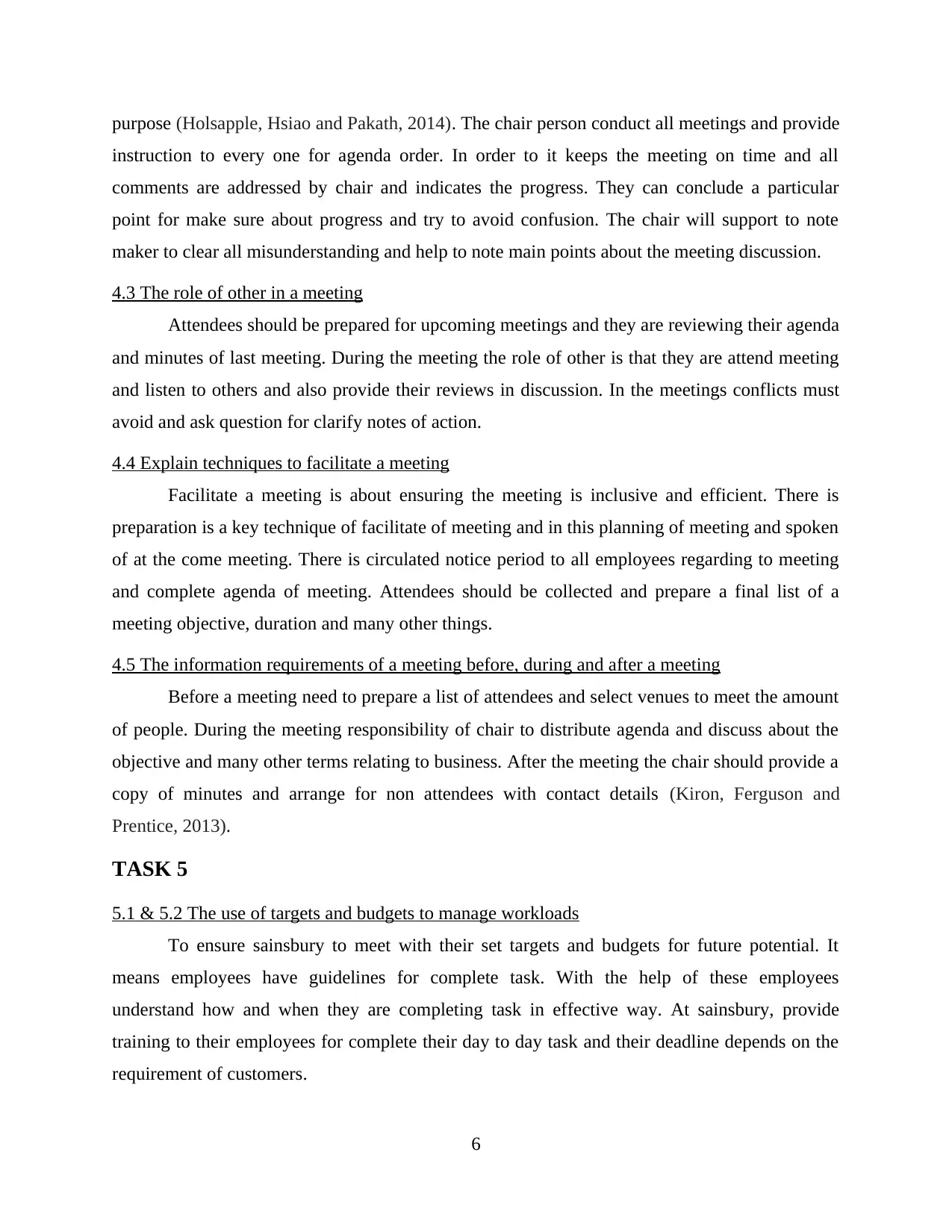
purpose (Holsapple, Hsiao and Pakath, 2014). The chair person conduct all meetings and provide
instruction to every one for agenda order. In order to it keeps the meeting on time and all
comments are addressed by chair and indicates the progress. They can conclude a particular
point for make sure about progress and try to avoid confusion. The chair will support to note
maker to clear all misunderstanding and help to note main points about the meeting discussion.
4.3 The role of other in a meeting
Attendees should be prepared for upcoming meetings and they are reviewing their agenda
and minutes of last meeting. During the meeting the role of other is that they are attend meeting
and listen to others and also provide their reviews in discussion. In the meetings conflicts must
avoid and ask question for clarify notes of action.
4.4 Explain techniques to facilitate a meeting
Facilitate a meeting is about ensuring the meeting is inclusive and efficient. There is
preparation is a key technique of facilitate of meeting and in this planning of meeting and spoken
of at the come meeting. There is circulated notice period to all employees regarding to meeting
and complete agenda of meeting. Attendees should be collected and prepare a final list of a
meeting objective, duration and many other things.
4.5 The information requirements of a meeting before, during and after a meeting
Before a meeting need to prepare a list of attendees and select venues to meet the amount
of people. During the meeting responsibility of chair to distribute agenda and discuss about the
objective and many other terms relating to business. After the meeting the chair should provide a
copy of minutes and arrange for non attendees with contact details (Kiron, Ferguson and
Prentice, 2013).
TASK 5
5.1 & 5.2 The use of targets and budgets to manage workloads
To ensure sainsbury to meet with their set targets and budgets for future potential. It
means employees have guidelines for complete task. With the help of these employees
understand how and when they are completing task in effective way. At sainsbury, provide
training to their employees for complete their day to day task and their deadline depends on the
requirement of customers.
6
instruction to every one for agenda order. In order to it keeps the meeting on time and all
comments are addressed by chair and indicates the progress. They can conclude a particular
point for make sure about progress and try to avoid confusion. The chair will support to note
maker to clear all misunderstanding and help to note main points about the meeting discussion.
4.3 The role of other in a meeting
Attendees should be prepared for upcoming meetings and they are reviewing their agenda
and minutes of last meeting. During the meeting the role of other is that they are attend meeting
and listen to others and also provide their reviews in discussion. In the meetings conflicts must
avoid and ask question for clarify notes of action.
4.4 Explain techniques to facilitate a meeting
Facilitate a meeting is about ensuring the meeting is inclusive and efficient. There is
preparation is a key technique of facilitate of meeting and in this planning of meeting and spoken
of at the come meeting. There is circulated notice period to all employees regarding to meeting
and complete agenda of meeting. Attendees should be collected and prepare a final list of a
meeting objective, duration and many other things.
4.5 The information requirements of a meeting before, during and after a meeting
Before a meeting need to prepare a list of attendees and select venues to meet the amount
of people. During the meeting responsibility of chair to distribute agenda and discuss about the
objective and many other terms relating to business. After the meeting the chair should provide a
copy of minutes and arrange for non attendees with contact details (Kiron, Ferguson and
Prentice, 2013).
TASK 5
5.1 & 5.2 The use of targets and budgets to manage workloads
To ensure sainsbury to meet with their set targets and budgets for future potential. It
means employees have guidelines for complete task. With the help of these employees
understand how and when they are completing task in effective way. At sainsbury, provide
training to their employees for complete their day to day task and their deadline depends on the
requirement of customers.
6
⊘ This is a preview!⊘
Do you want full access?
Subscribe today to unlock all pages.

Trusted by 1+ million students worldwide

Budgets helps to control finances and help to bring down risks of spending too much in
specific area in a company. It provides direction to company for meet current commitments like
as pays bills and suppliers. Target and budget are working together for meet objectives with in
allocated finances.
5.3 Different quality management techniques to manage the performance of an administrative
team
Quality management is used in all organisations to secure products and services are
consistent and help to maintained in high standard. It also helps in identify aims and achieve in
systematic manner. There are four techniques which are used by administrative team to manage
performance, these are – planning, control, improvement and assurance (Kohlhammer, Proff and
Wiener, 2013) .
Quality planning consist of standards and practice that will use in different task and
carrying out good result. It is important to allows employees to understand their role and
responsibilities.
Quality control focused on testing products and services to find faults in report to back
management and relate to launch of product.
Quality improvement is the level of where analysis performance which are improved or
not. For this technique company apply six sigma, TQM approach.
Quality assurance determine the fault and improvement of the product and services.
5.4 The techniques used to identify the need for improvements in team outputs and standards
The manager of sainsbury monitor of targets which have been achieved and standards
have been maintained. There are including some technique – analysis of individual's role and
their everyday role and working with a team, setting targets, checking products and giving
constructive feedback. These targets should be SMART. These targets to allow for progress
reviews before the targets deadline and the time frame of the task can be determined.
TASK 6
6.1 The characteristics, requirements and purposes of different types of events
sainsbury organise various types of events on the time of festivals and provides discounts
to their customers. Every event has primary objective and purpose for analysis of success and
growth of an organisation. The characteristics of an event like as structure, activities and
7
specific area in a company. It provides direction to company for meet current commitments like
as pays bills and suppliers. Target and budget are working together for meet objectives with in
allocated finances.
5.3 Different quality management techniques to manage the performance of an administrative
team
Quality management is used in all organisations to secure products and services are
consistent and help to maintained in high standard. It also helps in identify aims and achieve in
systematic manner. There are four techniques which are used by administrative team to manage
performance, these are – planning, control, improvement and assurance (Kohlhammer, Proff and
Wiener, 2013) .
Quality planning consist of standards and practice that will use in different task and
carrying out good result. It is important to allows employees to understand their role and
responsibilities.
Quality control focused on testing products and services to find faults in report to back
management and relate to launch of product.
Quality improvement is the level of where analysis performance which are improved or
not. For this technique company apply six sigma, TQM approach.
Quality assurance determine the fault and improvement of the product and services.
5.4 The techniques used to identify the need for improvements in team outputs and standards
The manager of sainsbury monitor of targets which have been achieved and standards
have been maintained. There are including some technique – analysis of individual's role and
their everyday role and working with a team, setting targets, checking products and giving
constructive feedback. These targets should be SMART. These targets to allow for progress
reviews before the targets deadline and the time frame of the task can be determined.
TASK 6
6.1 The characteristics, requirements and purposes of different types of events
sainsbury organise various types of events on the time of festivals and provides discounts
to their customers. Every event has primary objective and purpose for analysis of success and
growth of an organisation. The characteristics of an event like as structure, activities and
7
Paraphrase This Document
Need a fresh take? Get an instant paraphrase of this document with our AI Paraphraser
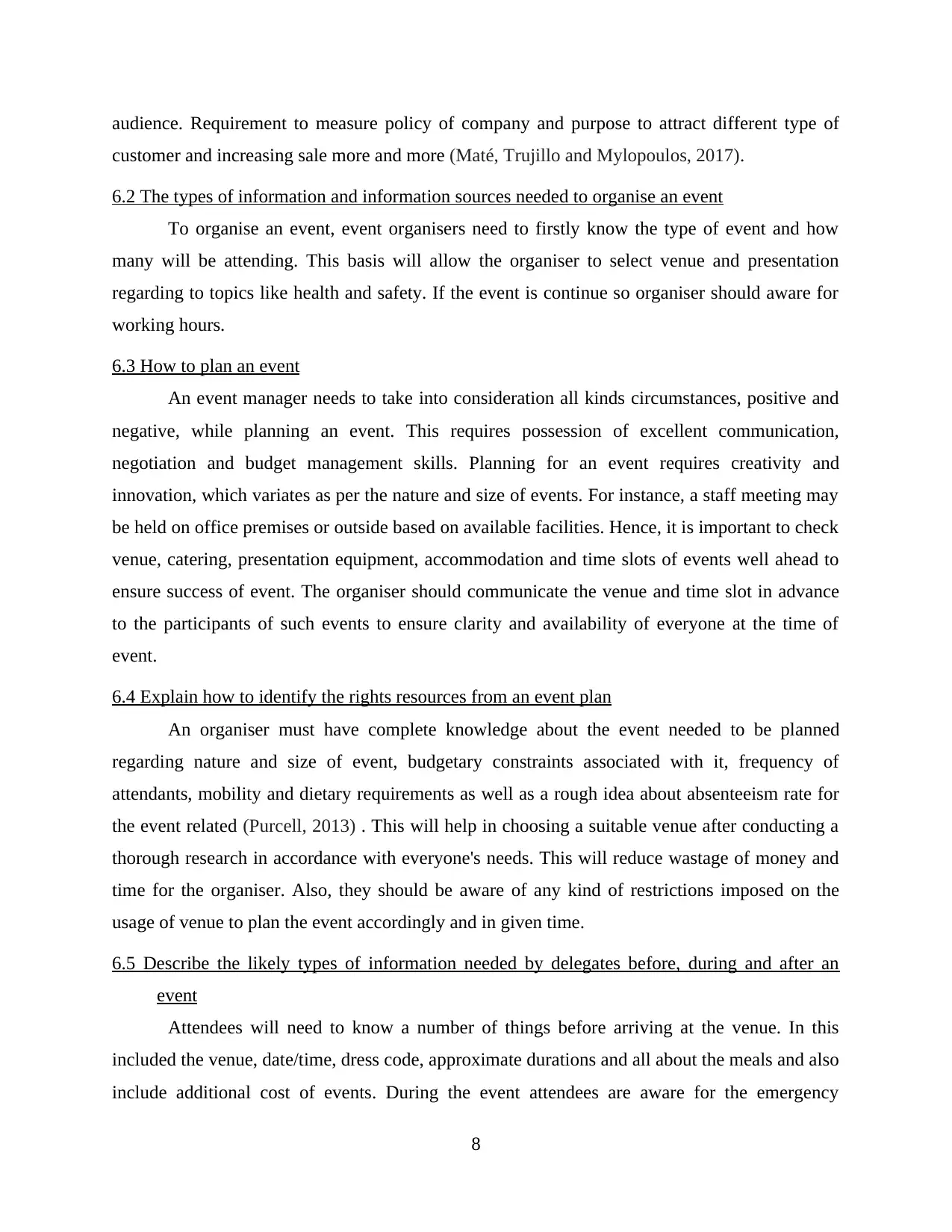
audience. Requirement to measure policy of company and purpose to attract different type of
customer and increasing sale more and more (Maté, Trujillo and Mylopoulos, 2017).
6.2 The types of information and information sources needed to organise an event
To organise an event, event organisers need to firstly know the type of event and how
many will be attending. This basis will allow the organiser to select venue and presentation
regarding to topics like health and safety. If the event is continue so organiser should aware for
working hours.
6.3 How to plan an event
An event manager needs to take into consideration all kinds circumstances, positive and
negative, while planning an event. This requires possession of excellent communication,
negotiation and budget management skills. Planning for an event requires creativity and
innovation, which variates as per the nature and size of events. For instance, a staff meeting may
be held on office premises or outside based on available facilities. Hence, it is important to check
venue, catering, presentation equipment, accommodation and time slots of events well ahead to
ensure success of event. The organiser should communicate the venue and time slot in advance
to the participants of such events to ensure clarity and availability of everyone at the time of
event.
6.4 Explain how to identify the rights resources from an event plan
An organiser must have complete knowledge about the event needed to be planned
regarding nature and size of event, budgetary constraints associated with it, frequency of
attendants, mobility and dietary requirements as well as a rough idea about absenteeism rate for
the event related (Purcell, 2013) . This will help in choosing a suitable venue after conducting a
thorough research in accordance with everyone's needs. This will reduce wastage of money and
time for the organiser. Also, they should be aware of any kind of restrictions imposed on the
usage of venue to plan the event accordingly and in given time.
6.5 Describe the likely types of information needed by delegates before, during and after an
event
Attendees will need to know a number of things before arriving at the venue. In this
included the venue, date/time, dress code, approximate durations and all about the meals and also
include additional cost of events. During the event attendees are aware for the emergency
8
customer and increasing sale more and more (Maté, Trujillo and Mylopoulos, 2017).
6.2 The types of information and information sources needed to organise an event
To organise an event, event organisers need to firstly know the type of event and how
many will be attending. This basis will allow the organiser to select venue and presentation
regarding to topics like health and safety. If the event is continue so organiser should aware for
working hours.
6.3 How to plan an event
An event manager needs to take into consideration all kinds circumstances, positive and
negative, while planning an event. This requires possession of excellent communication,
negotiation and budget management skills. Planning for an event requires creativity and
innovation, which variates as per the nature and size of events. For instance, a staff meeting may
be held on office premises or outside based on available facilities. Hence, it is important to check
venue, catering, presentation equipment, accommodation and time slots of events well ahead to
ensure success of event. The organiser should communicate the venue and time slot in advance
to the participants of such events to ensure clarity and availability of everyone at the time of
event.
6.4 Explain how to identify the rights resources from an event plan
An organiser must have complete knowledge about the event needed to be planned
regarding nature and size of event, budgetary constraints associated with it, frequency of
attendants, mobility and dietary requirements as well as a rough idea about absenteeism rate for
the event related (Purcell, 2013) . This will help in choosing a suitable venue after conducting a
thorough research in accordance with everyone's needs. This will reduce wastage of money and
time for the organiser. Also, they should be aware of any kind of restrictions imposed on the
usage of venue to plan the event accordingly and in given time.
6.5 Describe the likely types of information needed by delegates before, during and after an
event
Attendees will need to know a number of things before arriving at the venue. In this
included the venue, date/time, dress code, approximate durations and all about the meals and also
include additional cost of events. During the event attendees are aware for the emergency
8

procedures at the site and location of facilities like bath room. After the event circulate feedback
and questionnaire for improve quality of event in effective way (Zhao, Fan, and Hu, 2014).
CONCLUSION
As per the above discussion it is concluded that business administration is provided many
facilities regarding to office meetings, minutes, event and many more. There is following legal
requirement according to corporation and create health working environment of employees
according to work place. There is prepare various plans and strategies to implement their task in
effective way and help to top management for play their role and responsibilities. There are
provided information according to meetings and events. These are helpful to improve skills and
knowledge or particular person and team and they can aware for products and services of
corporation.
9
and questionnaire for improve quality of event in effective way (Zhao, Fan, and Hu, 2014).
CONCLUSION
As per the above discussion it is concluded that business administration is provided many
facilities regarding to office meetings, minutes, event and many more. There is following legal
requirement according to corporation and create health working environment of employees
according to work place. There is prepare various plans and strategies to implement their task in
effective way and help to top management for play their role and responsibilities. There are
provided information according to meetings and events. These are helpful to improve skills and
knowledge or particular person and team and they can aware for products and services of
corporation.
9
⊘ This is a preview!⊘
Do you want full access?
Subscribe today to unlock all pages.

Trusted by 1+ million students worldwide
1 out of 13
Related Documents
Your All-in-One AI-Powered Toolkit for Academic Success.
+13062052269
info@desklib.com
Available 24*7 on WhatsApp / Email
![[object Object]](/_next/static/media/star-bottom.7253800d.svg)
Unlock your academic potential
Copyright © 2020–2025 A2Z Services. All Rights Reserved. Developed and managed by ZUCOL.





